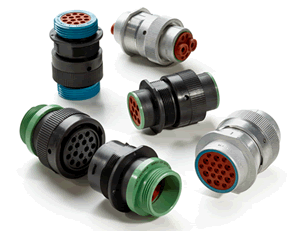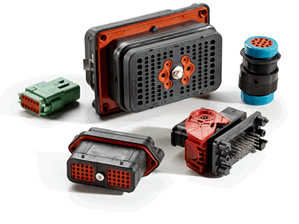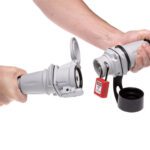Ruggedizing connectors for harsh conditions
In heavy industries, vibration, temperature extremes, chemicals, and fluids take their toll on electrical systems. Just one small leak or fault in an electrical system can stop farming operations, cripple a military vehicle, or immobilize a fire truck.
Harsh environment connectors feature several design elements to help protect connections. These features include durable contacts, watertight seals, rugged metal or thermoplastic shells, and a firm, secure locking mechanism. Applications for these types of connector products include ECUs, joysticks, industrial and marine engines, control boxes, lights and CAN systems, just to mention a few.
Connector bodies must be able to stand up to the conditions they will face in the field and on worksites. They are critical components in vehicles where downtime isn’t acceptable: tanks, troop carriers, ambulances, tractors, and earth movers, to name just a few.
Rugged connector features protect electrical connections
Rugged all-metal bodies and corrosion resistant thermoplastic shells must be manufactured from high quality materials selected for their ability to withstand years of environmental exposure. Metal connectors should be built to withstand the force and shock of hard impacts that the connectors face in rough environmental conditions. High-grade thermoplastic connectors need to be engineered to be flame and chemical resistant. Many rugged connectors are available in rectangular or cylindrical body shapes. For harsh environments, they should feature wide operating temperature ranges, secure locking mechanisms, and a positive contact retention system.
Fluid resistant seals are crucial for connectors in harsh environments. Heavy-duty silicone seals and grommets must work together providing redundant barriers to contamination by fitting tightly around wire insulation and the connector interface. They must be resistant to most common industrial and engine fluids and retain their flexibility across a wide temperature range. A gastight, watertight, reliable environmental seal that prevents corrosion and contamination from interrupting the continuity of flow is preferred.

Many parameters are needed to seal connectors.
Proper contact alignment is another important aspect of environmentally sealed electrical connectors built for harsh environment applications. Secondary locks that snap into or onto the mating face of a connector are often used to help make sure that the contacts slide together properly when they are mated. Terminal position assurance (TPA) accessories such as wedge locks provide additional stability to both the contact barrel and the mated connectors. Many connector wedge locks and TPAs are offered with keying options, further enhancing their design flexibility.
A firm, secure locking mechanism that can withstand vibration and shock is critical for maintaining a steadfast connector engagement. Connectors can be held together by push-latches, threaded coupling rings, lever locks, or tightened together by jackscrews. The locking mechanisms should be easy to engage and disengage and give an audible or tactile signal when they are securely fastened. Once fastened, the locking mechanisms are able to prevent disengagement due to vibration or impact.
Common contacts, tooling, and processes
Design consistency on a wiring harness streamlines production and field service. Common elements that simplify assembly include contacts, tooling, and processes. When connectors use the same processes, contacts, and tooling, training time is reduced and production is streamlined and simplified. Consistency in production creates a higher quality finished product with less down time and fewer warranty claims. Process consistency also significantly reduces assembly time and simplifies field service.

Consistency helps ensure data integrity.
Contacts are the heart of any connector. If the continuity of signal and power through the contacts is not maintained, systems and applications can fail. A common contact system improves performance, reliability, and maintainability by reducing changes in the assembly of the wire harness. The use of a common contact system eliminates many of the failures reported in harnesses where hundreds of different terminations are used.
The variation point among the contacts is the size of the terminal, which is dictated by the wire gauge. To help confirm a proper crimp and achieve the highest performance specifications, contacts must be crimped with proper tooling.
Crimp terminations made in the field should provide the same reliability as those preformed in the factory, using similar and appropriate tooling, and with similar ease of operation. Strength, accuracy, and the overall reliability of a crimped contact should be controlled by the crimp tool, not the operator.
Even a small degradation in electrical connections can be critical to industrial vehicles, so equipment manufacturers are turning to environmentally sealed electrical connectors to help keep their equipment running. TE Connectivity’s DEUTSCH connectors have the rugged features and the common contacts, tooling, and processes that equipment manufacturers need for harsh conditions.
[hr]
Chad Roberts is a communications marketing analyst at TE Connectivity.
Recently posted:
[related_posts limit=”10″]






